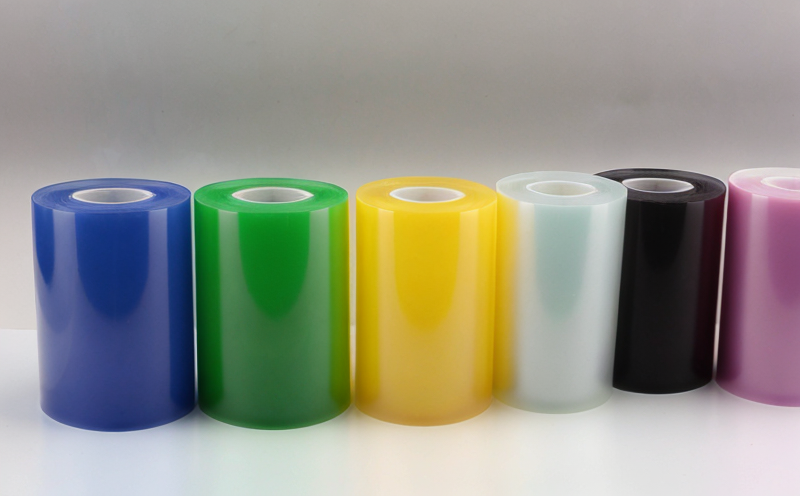UNE EN ISO 22007 Thermal Conductivity Testing of Plastic Films
The thermal conductivity test according to UNE EN ISO 22007 is a critical procedure for assessing the insulating properties and energy efficiency of plastic films. This standard ensures that manufacturers can accurately measure how heat passes through their products, which is essential for optimizing performance in various applications such as packaging, construction materials, and electronics.
Thermal conductivity testing plays a pivotal role in ensuring compliance with international standards and regulations aimed at enhancing energy efficiency and reducing environmental impact. The test involves measuring the rate of heat transfer between two surfaces separated by a thin layer of plastic film. This measurement helps determine whether the material is suitable for specific applications, such as insulating films or packaging materials that need to prevent temperature changes.
The UNE EN ISO 22007 standard specifies the apparatus and procedures required for conducting thermal conductivity tests on plastic films. It ensures consistency across different laboratories worldwide, enabling accurate comparisons of results between various manufacturers and suppliers. By adhering to these guidelines, labs can provide reliable data that supports informed decision-making processes in industries reliant upon precise thermophysical properties.
Proper specimen preparation is crucial for obtaining valid measurements according to UNE EN ISO 22007. Specimens must be cut into standard sizes and shapes before testing; these dimensions are specified within the scope of the standard itself. Additionally, specimens need to be conditioned in a controlled environment prior to testing in order to eliminate any residual stresses that could affect measurement accuracy.
Appropriate test equipment is essential for accurate thermal conductivity measurements according to UNE EN ISO 22007. The equipment used should meet the requirements outlined in the standard, including precise temperature control capabilities and highly sensitive sensors capable of detecting even small variations in heat flow through the specimen.
The results obtained from this test will indicate how well the plastic film insulates against heat transfer. This information can be used by manufacturers to improve their products' energy efficiency ratings or design new materials with specific thermal characteristics suited for particular applications.
| Aspect | Description |
|---|---|
| Sample Preparation | The samples should be conditioned to the specified temperature and humidity conditions before testing. |
| Test Equipment | The equipment used for this test must comply with UNE EN ISO 22007 requirements, including precise temperature control capabilities and sensitive sensors. |
| Aspect | Description |
|---|---|
| Testing Procedure | The test procedure involves placing the sample between two plates maintained at different temperatures and measuring the rate of heat transfer through the film. |
| Data Analysis | The collected data is analyzed to determine the thermal conductivity value according to UNE EN ISO 22007 criteria. |
- Thermal conductivity tests are essential for evaluating insulation properties across various industries including packaging, building materials, and electronics.
- UNE EN ISO 22007 ensures consistent measurements worldwide by specifying required apparatus and procedures.
- Proper specimen preparation is critical to obtaining accurate results; samples must be cut into standard sizes and conditioned appropriately.
Scope and Methodology
The scope of UNE EN ISO 22007 thermal conductivity testing includes the measurement of heat transfer rates through plastic films under controlled conditions. The methodology involves preparing standard-sized specimens, conditioning them in a specified environment, then placing these samples between two plates kept at different temperatures. Heat flow is measured using sensitive sensors until equilibrium is achieved. Results are analyzed to determine the thermal conductivity value according to UNE EN ISO 22007 criteria.
| Aspect | Description |
|---|---|
| Sample Preparation | The samples should be conditioned to the specified temperature and humidity conditions before testing. |
| Test Equipment | The equipment used for this test must comply with UNE EN ISO 22007 requirements, including precise temperature control capabilities and sensitive sensors. |
| Aspect | Description |
|---|---|
| Testing Procedure | The test procedure involves placing the sample between two plates maintained at different temperatures and measuring the rate of heat transfer through the film. |
| Data Analysis | The collected data is analyzed to determine the thermal conductivity value according to UNE EN ISO 22007 criteria. |
Eurolab Advantages
EuroLab offers unparalleled expertise in performing UNE EN ISO 22007 thermal conductivity tests for plastic films. With state-of-the-art facilities and highly trained professionals, we ensure precise measurements and accurate reporting that meet international standards. Our services cater to quality managers, compliance officers, R&D engineers, and procurement teams who require reliable data on the insulating properties of their materials.
Our team leverages advanced technology and methodologies to provide consistent results across all tests conducted according to UNE EN ISO 22007. By choosing EuroLab for your thermal conductivity testing needs, you can be confident in receiving high-quality services that contribute to better decision-making processes within your organization.
In addition to accurate measurements, we also offer comprehensive support throughout the entire testing process—from specimen preparation to final analysis and reporting. Our experienced professionals are available to assist with any inquiries or concerns related to UNE EN ISO 22007 thermal conductivity tests.
Environmental and Sustainability Contributions
- Evaluating the insulating properties of plastic films helps reduce energy consumption in various applications, leading to lower carbon footprints.
- Accurate thermal conductivity measurements contribute to the development of more efficient building materials and packaging solutions.
- The results from these tests can inform improvements in product design aimed at enhancing overall sustainability performance.





